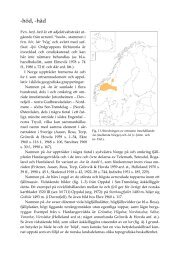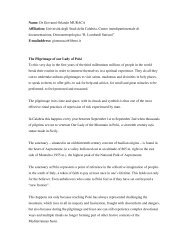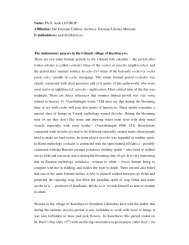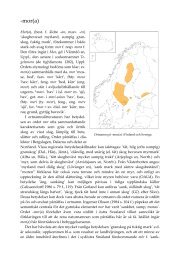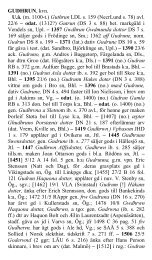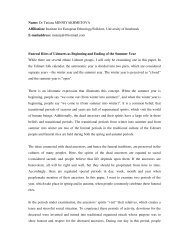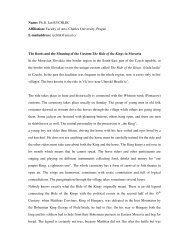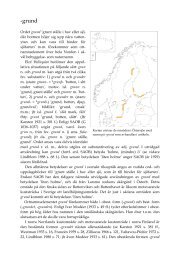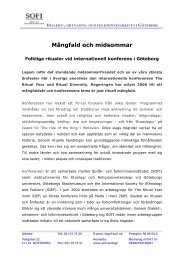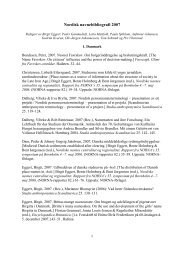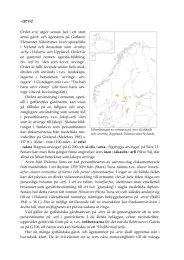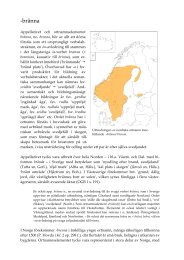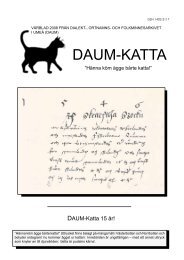NORNA-RAPPORTER 88 Binamn. Uppkomst, bildning, terminologi ...
NORNA-RAPPORTER 88 Binamn. Uppkomst, bildning, terminologi ...
NORNA-RAPPORTER 88 Binamn. Uppkomst, bildning, terminologi ...
You also want an ePaper? Increase the reach of your titles
YUMPU automatically turns print PDFs into web optimized ePapers that Google loves.
Bynames as an expression of identity 25<br />
gill and Leildé (2006:11–13) provide a useful outline of the new context . Contemporary<br />
theorists seem to agree that contingency and uncertainty have become<br />
major role players in individual or collective representations. Bauman<br />
(1996:50–51) describes the current state of affairs well:<br />
[P]ostmodernity is the point at which modern untying (dis-embedding,disencumbering)<br />
of tied (embedded, situated) identities reaches its completion: it is now<br />
all too easy to choose identity, but no longer possible to hold it … Postmodernity<br />
is the condition of contingency ... nothing seems impossible, let alone unimaginable.<br />
Everything that ‘is’, is until further notice.<br />
It appears as if it is now widely acknowledged that individuals draw meaning<br />
from belonging to more than one group. They construct and maintain multiple<br />
identities that emerge under different circumstances in their lives. These identities<br />
are open to change as circumstances, strategies and interactions fluctuate,<br />
and identity should best be viewed as a ‘process’ rather than a property. If seen<br />
as such, it remains emergent, never complete, finalised or fixed, but always in<br />
the making. Identity is therefore determined by what we ‘do’, rather than by<br />
what we ‘are’ (see Puttergill & Leildé 2006).<br />
In a South African context these developments are also very prominent. In<br />
pre-1994 (apartheid) South Africa, identities were often manipulated, suppressed<br />
and imposed. In post-1994 in the ‘new’ South Africa, freed from these<br />
inhibiting factors from the past, and particularly in a multilingual and multicultural<br />
country like South Africa, it is certainly not surprising and actually fascinating<br />
to see how cultural hierarchies and the forced ethnicities of the past are<br />
undermined by many, and how new expressions of identity are revealed on our<br />
television screens, on stage, behind microphones and in books. Wassermann<br />
and Jacobs (2003), editors to a publication on South African identities called<br />
Shifting Selves, stress the point in the introduction that identity is a journey, not<br />
a destination. It is forever constructed anew as the social context changes. Individual<br />
identities will adapt, adjust or change according to the new circumstances.<br />
All of the aforegoing suggests that it would be a rather futile attempt to adequately<br />
describe or fix identity. One can, however, still explore the names of<br />
individuals as an expression of identity. When dealing with names, it is important<br />
to note that a proper name has unique reference, and we can speak of<br />
onymic identity, i.e. the identity of names, when the same name is used for the<br />
same entity at different times in language use (speech or writing) over time.<br />
Every time a name is used, we are dealing with a ‘nome’ (name), i.e. an expression<br />
of the same proper name in language use. Should two different persons<br />
bear the same name form, one could speak of homophony. In a wider sense,<br />
‘name’ and ‘named’ are conceived of as existing in a diachronic continuum,<br />
ranging from their origin to the present day, at least in the minds of the contemporary<br />
speaking community.



